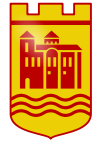Asenovgrad
|
Asenovgrad Асеновград |
||
|---|---|---|

Centre
|
||
|
||
| Location of Asenovgrad | ||
| Coordinates: 42°1′N 24°52′E / 42.017°N 24.867°ECoordinates: 42°1′N 24°52′E / 42.017°N 24.867°E | ||
| Country | Bulgaria | |
|
Province (Oblast) |
Plovdiv | |
| Government | ||
| • Mayor | Emil Karaivanov | |
| Area | ||
| • City | 78.012 km2 (30.121 sq mi) | |
| Elevation | 269 m (883 ft) | |
| Population (Census February 2011) | ||
| • City | 54,778 | |
| • Density | 700/km2 (1,800/sq mi) | |
| • Urban | 65,962 | |
| Time zone | EET (UTC+2) | |
| • Summer (DST) | EEST (UTC+3) | |
| Postal Code | 4230 | |
| Area code(s) | 0331 | |
| License plate | PB | |
| Climate | Cfa | |
| Website | Official website | |
Asenovgrad (Bulgarian: Асеновград, until 1934 Stanimaka, Bulgarian: Станимака; Greek: Στενήμαχος) is a town in central southern Bulgaria, part of Plovdiv Province. It is the largest town in Bulgaria that is not a province center.
Asenovgrad was founded by the Thracians as Stenímachos (Greek: Στενήμαχος) around 300–400 BC. In 72 BC the city was captured by the troops of the Roman Empire as part of the Roman expansion towards the Black Sea. After a long period of peace, the town was destroyed by the Goths in 251, but rebuilt later. In 395 the Roman Empire was divided into two parts and the city fell under Byzantine Empire control. Afterwards, the Slavic tribes flooded the region (until around 700 AD) and became the majority of the population.
During the wars between the Bulgarian Empire and the Byzantine Empire, the city became a major military stronghold for the Bulgarian rulers. Due to aggravation of the relationships with the Latin Empire, in 1230 Bulgarian Tsar Ivan Asen II strengthened the local fortress Stanimaka and for this reason the city was named after him in 1934 (literally city of Asen). After Bulgaria was conquered by the Ottoman Empire, Roma and Turks settled in Stanimaka, and nowadays make up 15% of the municipality of Asenovgrad's population, the rest 75% being ethnic Bulgarians and 10% – unknown and others.
...
Wikipedia


